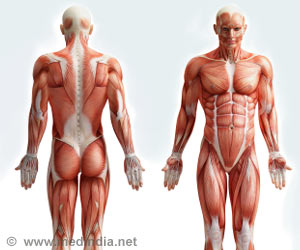Between 30 and 60 minutes of muscle strengthening activity every week is linked to a 10% to 20% lower risk of death from all causes, and from cardiovascular disease, diabetes, and diagnosis of cancer analysis compiled data from available sources, as published online in the
.
The findings are independent of aerobic exercise. But the analysis points to a J-shaped curve for most effects, and there was no conclusive evidence that more than one hour per week further reduces the risk of muscle strengthening activity.
Physical activity guidelines recommend regular muscle strengthening activities for adults, primarily due to the known benefits for skeletal muscle health (e.g., weight lifting; resistance bands work; push-ups, sit-ups and squats; heavy gardening like drilling and shovelling).
The research that was conducted previously indicated that muscle strengthening activity is directly associated with a lower risk of death, but it was generally not known what the optimal ‘dose’ might be.
Currently, the researchers examined research databases for relevant prospective studies that included adults without major health issues who were monitored for at least 2 years.
The final analysis includes 16 studies in the initial cache of 29. The initial study was published in 2012, and most of the studies were conducted in the USA, with the rest coming from England, Scotland, Australia, and Japan. The maximum observational period lasted 25 years.
The number of study participants varied from approximately 4,000 to 480,000, and ranged in age from 18 to 97 years. Twelve studies included men and women; two men only and three women only. All studies consider aerobic or other types of physical activity and muscle strengthening activities.
The compiled data analysis shows that muscle strengthening functions are associated with a 10% to 17% lower death risk from any cause, as well as deaths from heart disease and stroke, cancer, diabetes, and lung cancer.
Muscle strengthening and reduced risk of specific types of cancer, including those of the bowel, kidney, bladder, or pancreas had no association.
In analysis, two types of curves were observed: a J-shaped curve and an L-shaped curve. The first one, with a maximum risk reduction of between 10% and 20% at approximately 30 to 60 minutes/week of muscle strengthening activities for death from any cause, was observed. The second was observed for diabetes, with a large risk reduction up to 60 minutes/week of muscle strengthening activities, after which there was a gradual tapering off.
Joint analysis showed that on combining these muscle strengthening and aerobic activities, the reduction in risk of death from any cause, cardiovascular disease, and cancer was greater: 40%, 46%, and 28% lower.
The researchers agree on some limitations to their findings, the most important of which is that data from only a few studies were collected for each effect studied. The studies also relied on a subjective assessment of muscle strengthening activities.
The researchers cautioned that the results may not be globally applicable as most of it was studied outside United States and the included studies were all observational rather than clinical trials.
The authors write that the potential of a higher volume of muscle strengthening activities on the reduction in risk of death is still unclear, given the J-shaped associations.
But the authors conclude, “The combination of muscle strengthening and aerobic activities may provide a greater benefit for reducing all-cause, [cardiovascular disease], and total cancer mortality.”
“Given that the available data are limited, further studiessuch as studies focusing on a more diverse populationare needed to increase the certainty of the evidence.”
Source: Medindia



